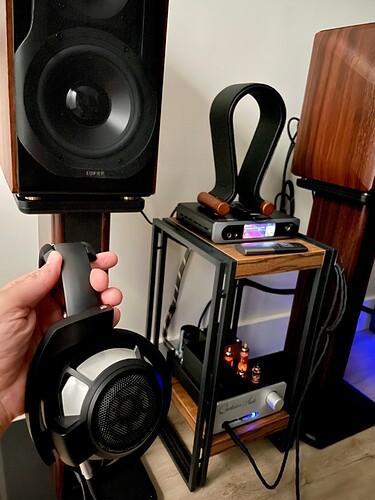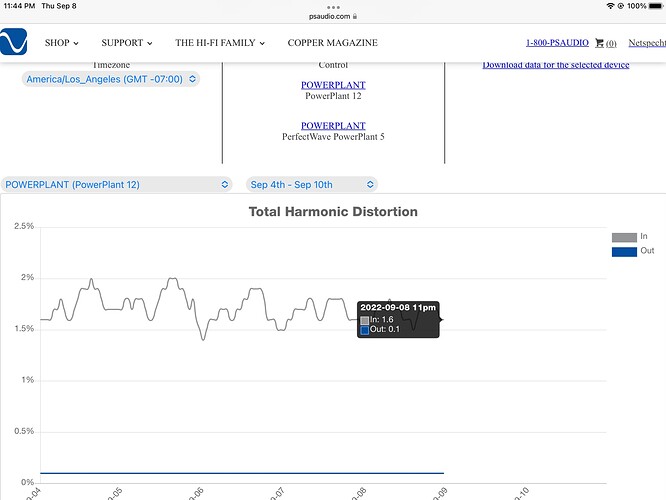Yes, I should have added that, indeed, using the line out is usually preferable over using a pre-out. It’s not always possible on some sources, or there may be other design choices such as digital volume controls on a DAC/pre which may or may not be good, or the volume pot on the headphone amp may best be bypassed if it is inferior to the one in the pre-amp.
The volume pot alone on my headphone amp costs around $700 wholesale so not a problem.
I can agree with this
Wouldn’t you be better using the headphone pot (assuming cost = quality) to control volume then?
This scenario is another reason I prefer a fixed level out to a headamp over using variable pre out. Whether thats a line / loop or digitally fixed is a mute point, it’s still fixed line level out with one pot for signal output control, with that pot being on the actual head Amp.
I have tried it both ways, max vol on amp and adjust volume with headphone and the way I stated before, could not hear a difference worth the risk of having the amp at max volume and switching back to speakers having forgotten it is at full volume and the consequences of that.
The volume control on the amp is also excellent .
The question is that you’ll never “need” anything. The point is with HD800S; you should have a proper amp for it. I used the headphone output from my Matrix mini-i Pro 3, but the music became a different story when I bought the QuickSilver amp. So, depending on what you want, you’ll always have room for sound improvements, but start small, enjoy what you have, and, little by little, try to improve it.
I’m building a small setup with my Matrix mini-i 3 Pro as DAC. The sound comes from my QNAP NAS as a Roon server, and the DAC can reproduce it without loss. I can either output to Edifier speakers using XLR DAC output from the DAC or send it to my beloved QuickSilver headphone amp. I have the Sennheiser 800S and used to listen to classical music most of the time. The sound is rich and detailed. Now I’m thinking about upgrading. I guess I’ll start with the headphones. I’m thinking about Dan Clark Stealth and the OOR Ferrum amp.
HD800s - I would urge you to consider the Hifiman Arya as a less expensive option without the known harsh/bright drawbacks of the HD800s. Magnificent soundstage, neutral frequency response, dive deep into detail, unflappable accuracy. Musical engagement every time.
Great advice from the person who suggested a Raspberry Pi with headphone amp. As many have noted in this thread, there are a ton of affordable high quality headphone amps with built-in DACs. Most should be an upgrade from your amp’s headphone out. Using a Raspberry Pi micro-computer as a Roon endpoint is inexpensive and easy. At that point you can plug in any USB-equipped headphone amp that you want. There is also a cool upgrade path by adding a beefy power supply to the Pi down the track.
In the meantime, plug your new headphones, whatever they turn out to be, into your existing amp via a 3.5 adaptor and enjoy!
Curious - what sorts of power supply upgrades are suggested for a Pi that feeds a headphone dac/amp? (In my case a chord mojo)?
None. Unless of course you like upgrading.
This no-name power supply brand on Amazon gave me a significant improvement amazon.com/gp/product/B08HDGCP3V.
I was prepared to get no improvement. Wanted to convert my Pi power supply from 220v to 110v, took a punt on the low price to see if it would make any difference over the standard Pi wall wart. Was surprised by a substantial improvement along the lines you would reasonably expect with adding a better power supply to decent hi-fi components.
See my full comment on this thread: Raspberry pi 4b ultra low noise Power Supply - #15 by Sven_Eschholz
Presumably all down to a reduction in noise in the audio signal.
Apologies for taking the OP’s thread off course!
So you were expecting an improvement after all.
You just read into my words what you wanted to be true. Confess to confirmation bias you trolling scoundrel! ![]()
I confess. You should too.
You could use an Ifi 5v PS, or 5v LPS, but I doubt you’ll notice a difference.
FYI, Chord will tell you (bluntly) to use the stock power supply. If you were meant to use something else, they would have supplied it. The stock Chord PS is decent, as least it is on my Qutest,
A good quality power supply is useful for maintaining regulated voltage. Some components come with junk switching power supplies that cost $5-10 (or less). A good power supply is more for practical purposes, offering a dependable delivery of steady voltage to your component. It’s unlikely to enhance the sound quality. If you have a high end system, you might consider a regenerator to clean up line voltage.
Oh wow, that’s tens of thousands of Naim, Origin Live and Graham Slee users whose experienced ears you just contradicted with that sweeping statement (not to mention every other manufacturer who offers power supply upgrades).
Again, apologies to the OP for my innocent lived experience statement inviting the hobby horse equestrians to the party.
I have several upgraded power supply devices (Channel Islands Audio, Wyred4Sound, ifi). I purchased them for the reasons stated in my post. I also have a regenerator in each of my two systems, so I have very clean power at the origin point.
If you can hear a difference between the different power supplies you use that’s awesome. My comments are based on my experiences. YMMV.
Pictured is a screen of my main system regenerator data. It depicts measured THD % from the line voltage output entering the unit from the wall receptacle, and measured corrected clean voltage being fed to the system. Line voltage is noisy. Some places (electric utility service providers) are better than others.
That’s a nice graph, but we’re not listening to the power supply. That is only used to get a DC voltage, which is regulated and thus stable.
If there is noise in the line, you are listening to it. Dimmers, motors, etc.
The graph is from a regenerator, not a power supply. Its mission is to clean power at the source.
@moderators can we split out the power supply back and forth please.

